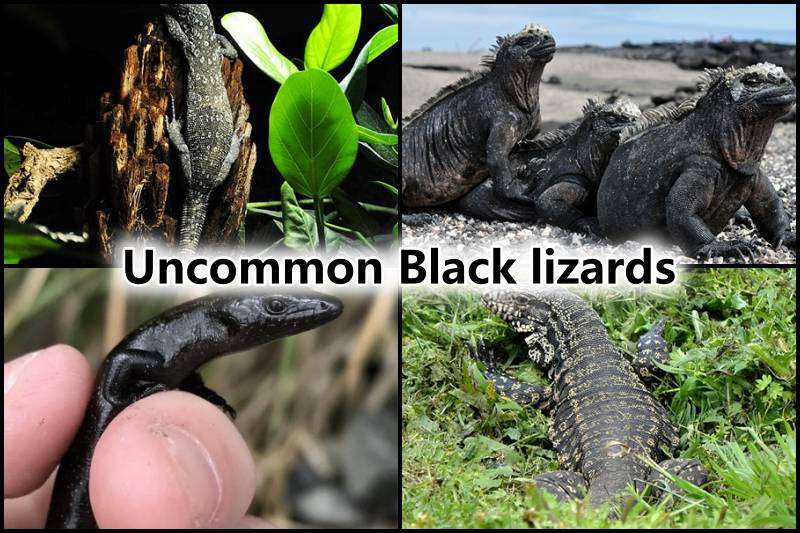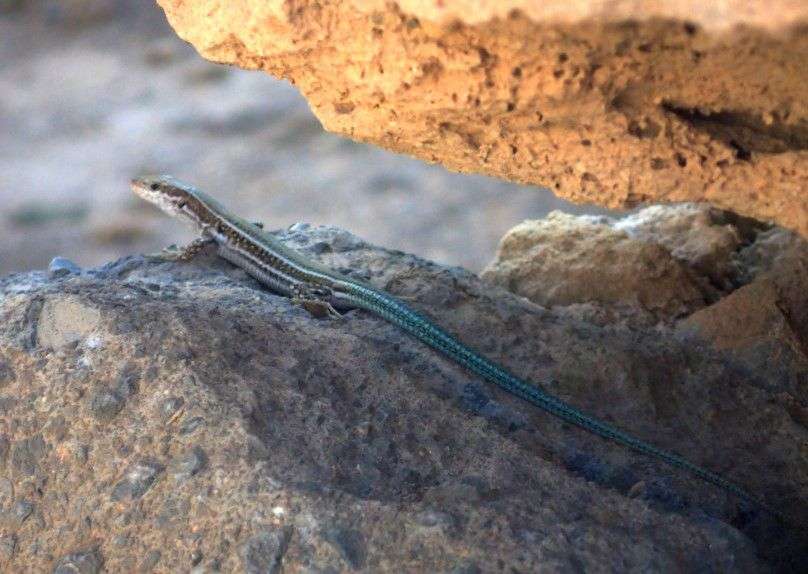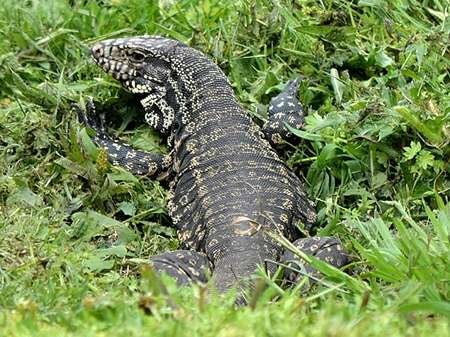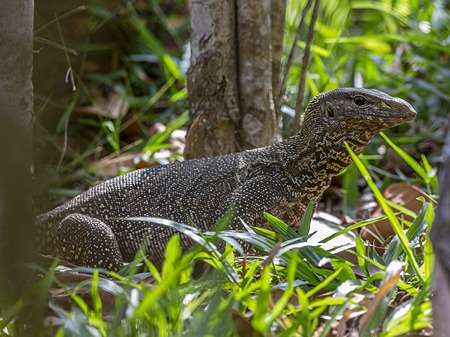Lizard body coloration can vary significantly between species and can range from shades of brown, gray, green, and black to vibrant colors such as red, orange, blue, and yellow.
Coloration in lizards can serve different purposes, like camouflage, thermoregulation, or as a warning signal to other individuals. Body coloration also depends on several factors like location, temperature, and other environmental factors, and some species can even change their coloration rapidly in response to different stimuli. In today’s list, we are going to talk about 10 Black Lizards in the world.
Are There Any Black Lizards?
Yes, there are plenty of black lizards in the world. Their bodies may be completely black, like that of the Black Girdled Lizard, or may occur in combination with other colors, like the Fence Skink.
Body textures may also differ considerably, depending on the species and several other environmental factors.
10 Uncommon Black lizards Worldwide
1) Black-girdled lizard
| Scientific name | Cordylus niger |
| Common name | swart-skurwejantjie, sonkykers (Afrikaans) |
| Size | ~7 centimeters |
| Weight | 10-30 grams |
| Location | endemic to Sub-Saharan Africa |
Black Girdled Lizards derive their species’ name from the word ‘niger,’ which popularly refers to black. The lizard is pitch black, giving it a melanistic look.
With shield-like pointy dorsal scales that girdle around its body in an imbricate manner, the Black Girdled Lizard appears to be well-armed.
Despite being a rocky lizard, preferring rocky crevices for shelter, one can occasionally spot them in gardens with ample amounts of shelter.
2) Fence Skink
| Scientific name | Cryptoblepharus virgatus |
| Common name | Wall Skink, Snake-eyed Skink |
| Size | ~10 centimeters |
| Weight | ~15 grams |
| Location | Queensland, Papua New Guinea |
Fence Skinks are small, slender lizards with white stripes going down to the tail from a black, brown, or gray body. A nocturnal species, Cryptoblepharus virgatus, consumes spiders and tiny insects.
It is well-known for having unusually placed eyes that are hidden by a transparent scale, giving the impression that it has no eyes, like that of a snake.
3) Argentine Black and White Tegu
| Scientific name | Salvator merianae |
| Common name | Black and White Tegu |
| Size | up to 4 feet in length |
| Weight | up to 7 kilograms |
| Location | native to South America |
The fourth lizard in this list of Black and White Lizards is the Argentine White Tegu, a popular pet among reptile lovers. These lizards derive their name from their mixed pattern of black and white dots and stripes over their bodies.
Despite being one of the largest species of tegus, the Argentine Black Tegu is quite docile and is an extremely intelligent animal that one can even house train it. Being an omnivore, they will devour almost anything from invertebrates and crustaceans to seeds and fruits.
4) Black and Yellow Striped Gecko
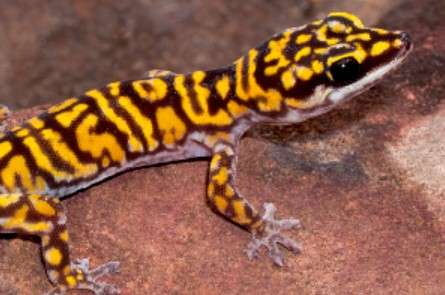
| Scientific name | Oedura marmorata |
| Common name | Marbled Velvet Gecko |
| Size | ~18 centimeters |
| Weight | 50-80 grams |
| Location | Madagascar |
It is a small, nocturnal gecko with wide, rounded eyes that are well adapted to seeing in the dark, a flat, triangular-shaped head, and striking black and white stripes.
The species uses its sticky tongue to capture its prey, which includes insects and other tiny invertebrates. They are extremely adaptable lizards that can survive in a range of environments, including forests to deserts.
Due to habitat loss and degradation, the Black and White Striped Geckos are regarded as a vulnerable species. To maintain the survival of this species in the wild, conservation efforts for both the animal and its environment are crucial.
5) Fringe-Toed Velvet Gecko

| Scientific name | Oedura filicipoda |
| Common name | Velvet Gecko |
| Size | ~2.5 inches |
| Weight | 20-30 grams |
| Location | endemic to Australia; now worldwide due to the pet trade |
The Fringe Toed Velvet Gecko comes in varying patterns and colorations, but the ones we are considering for this list are their hatchlings. Newly hatched individuals display a vivid banding pattern, thick black bands intercepted by thin white bands.
As they grow older, Fringe Toed Velvet Geckos will feed on insects and other small invertebrates, and being a nocturnal species, they will primarily forage at night.
6) Black Tree Monitor
| Scientific name | Varanus beccarii |
| Common name | Beccari’s monitor |
| Size | 90-120 centimeters |
| Weight | 8-10 grams |
| Location | Indonesia |
Black Tree Monitors are known for their distinctive black skin and yellow or green eyes, and along with their exceptionally long tails, they have an astonishing prehistoric appearance.
They feed on a variety of prey, including birds, reptiles, and mammals, and have powerful jaw and sharp teeth to help them capture and hold onto their food. These lizards are highly intelligent and social, which makes them a popular choice among pet lovers.
7) Asian Water Monitor
| Scientific name | Varanus salvator |
| Common name | Common Water Monitor, Rice Lizard, Ring Lizard |
| Size | ~2.5 meters |
| Weight | ~20 kilograms (males) |
| Location | South and Southeast Asia |
The next lizards on this list of Black Lizards are the second heaviest lizard, the Asian Water Monitor. With blackish to dark brown skin and yellowish near the belly region, the Asian Water Monitor has quite a distinctive appearance.
Their tails are compressed laterally, and they have bodies that are muscular and well-built. Their diet includes rodents, fish, birds, crabs, and preferably carrion.
8) Marine Iguana
| Scientific name | Amblyrhynchus cristatus |
| Common name | Sea Iguana, Saltwater Iguana |
| Size | up to 22 inches (excluding the tail) |
| Weight | 1-12 kilograms |
| Location | Galapagos Island |
The Marine Iguana demands a special position in the lizard family for being the only lizard capable of foraging in the ocean, where it feeds on algae. The coloration of Marine Iguanas, though black, may vary considerably depending on the location or the subspecies.
The black color helps to absorb heat from the sun after a long trip from the ocean. They also have sharp teeth and strong jaws that allow them to scrape algae off rocks and cliffs. Marine iguanas are considered a unique and iconic species of the Galápagos and are protected by law.
9) Fiordland Skink

| Scientific name | Oligosoma acrinasum |
| Common name | Fiordland Skink |
| Size | ~10 centimeters |
| Weight | ~8.5 grams |
| Location | Fiordland forests, South Islands, New Zealand |
Fiordland Skink is a Black Lizards species that live in forests and is distinguished by its striking black coloration with a silvery sheen. Fiordland skinks are nocturnal animals that eat spiders and insects.
They are one of the rarest skink species in New Zealand, and the loss of habitat and the introduction of predators are severely threatening their populations. To safeguard this species and its environment, conservation measures are underway.
10) Southern Coal Skink
| Scientific name | Plestiodon anthracinus |
| Common name | Coal Skink |
| Size | 5-7 inches |
| Weight | 0.2-0.3 grams |
| Location | Southeastern USA |
The last species of Black Lizard is the Southern Coal Skink, with a glossy black to dark brown body, giving it a coal-like appearance. Adult males develop dark orange coloration on the sides of their heads during the breeding season.
The Southern Coal Skink is a diurnal creature that eats insects and spiders. Although southern coal skink populations could be harmed by habitat loss and fragmentation, these animals are often not regarded as threatened or endangered.
Now we come to the end of our today’s article on 10 Black Lizards. We will be back soon, so until then, do check out our other articles on snakes, lizards, birds, fishes, and several other niches. I’m sure they won’t fail to fascinate you.
Also Read:

A zoology student turned writer. Nature has always been a magnet to me, and to unearth some of its secrets through my articles is my prime intention. If not engaging myself with nature and anime content, you can always find me going through some Bengali classics or filling the air with some soulful Tabla beats. An artist, trying to throw some colors to my blank canvas of life.
